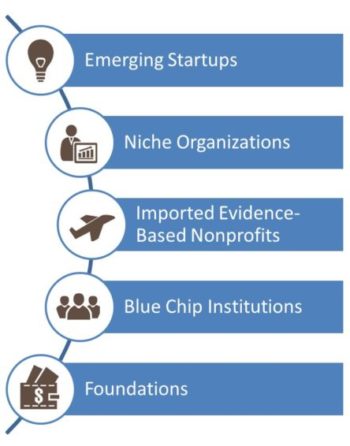by Josh Jacobson
This post launches a weekly series through mid-September outlining a new way to think about stewarding nonprofits in the Charlotte region – the Community Social Impact Portfolio.
A couple years ago, I decided to try my hand at investing. My wife and I had been utilizing a financial advisor who was primarily passively managing a system of 401ks and IRAs. I thought, why pay someone to do what I could do for myself?
I’m glad I did it, but it required me to become far more knowledgeable about concepts with which I was only partially familiar. The majority of our holdings were in mutual funds, and with a little bit of research, I was able to better understand how best to create a balanced, diversified portfolio that was responsive to the market. And on a semi-annual basis, I do a bit more research to rebalance the portfolio. We’re long-term investors so I tend not to pay it daily or weekly attention. But I rest easy at night knowing that my investments are optimized.
That notion of a diversified portfolio got me thinking – could the same principles be applied to optimize the nonprofit sector? How can donors have a similarly good feeling knowing that their social investments are producing positive returns for the community in which they live?
This concept has been a moment of inspiration for our consulting firm, which has taken a hard look at what makes a healthy social impact ecosystem, and as importantly, what we all can do to make it a reality.
The following blog post kicks off a six-part weekly series that will outline a way of thinking about the many nonprofits that serve our community and a call-to-action for all of us to get more strategic in how we foster what I like to call a “Community Social Impact Portfolio.”
Understanding the 501c3
To get started, we first have to all be on the same page with what it means to be a nonprofit organization. Believe it or not, board members for a large percentage of Next Stage’s client base have pretty profound misconceptions about the nonprofit they are charged with governing. The ah-ha moment typically comes when I share the following at the beginning of a board retreat:
This nonprofit is owned by me, it is owned by you, it is owned by everyone. A 501c3 charitable organization is a public entity that is charged with doing that which is in the best interest of the community it serves. Just like government. And you are its board members who have elected to take on its governance responsibility, ensuring that the organization serves the best interests of the broader public. And you don’t even get paid for it. What you have chosen to do on my behalf, on everyone’s behalf, is pretty exceptional. Thank you. Thank you for all you do and for being here this morning.
You can imagine the faces of these unsuspecting board members at this point, who are suddenly very present in the Saturday morning retreat they signed up for but did not fully understand. Excuse me, what?
It is generally not very well understood (particularly by nonprofit founders) that once an organization receives its 501c3 status, it has thus been given over to all people to “own.” In exchange, the US Internal Revenue Code allows for federal tax exemption for gifts to support its mission. It is a pretty decent trade off, but only if one truly understands what it means to give up control to the public.
Too Many Cooks
If we accept that nonprofits are owned by all of us as taxpayers, and are effectively doing the work government would do on our behalf if it had the interest in doing so, then surely we must have some form of control over how nonprofits are formed, right? I mean, if I encounter long lines at the DMV, it isn’t like I can just go down the road and set up my own DMV. There must be some form of checks and balances?
The answer is: nope. Technically, the IRS is the gatekeeper, but it isn’t a very discriminating arbiter. According the 2016 IRS Data Book, more than 86,000 new tax-exempt organizations came online in 2016 with just over 1,000 denied tax exempt-status. That means that more than 98% of organizations that apply for tax-exempt status receive it. And you and I don’t have very much control over that.
So what does that look like in practice? Charlotte is a great example of the explosion of nonprofit sector over the last twenty years. There are nearly 5,000 registered charities in Mecklenburg County alone (including roughly 3,600 public charities). While Mecklenburg County’s population has nearly doubled in the past 20 years, the number of public charities has increased three-fold.
Needless to say, this is an unsustainable trend. It creates duplication of services and unneeded competition for donor dollars. It creates backlash for founders of new nonprofits with truly game-changing strategies. And it reinforces a nonprofit culture that avoids taking risks for fear of losing ground.
It simply isn’t all that strategic.
Strategy is My… Middle Name
As a consultant to nonprofits in the Charlotte area for almost a decade, I’ve had the opportunity to work with more than 160 organizations of all shapes and sizes. My firm focuses on leveraging internal assets to meet external need. It requires being a student of our community.
This work has informed a philosophy that a healthy city must feature a variety of nonprofit organizations working in concert to address community needs. And just as a healthy stock portfolio should be diversified, a region’s nonprofit sector should include a carefully curated portfolio of community resources.
In fact, I’d suggest that all nonprofit organizations in the Charlotte region should fall into one of five categories:
 Emerging Startups – Not every new nonprofit contributes to the bloat described above. The nonprofit sector is ripe for disruption, and social entrepreneurs with new and different ways to achieve success are needed now more than ever. Sometimes these individuals should be encouraged to align with already-developed nonprofits, but other times there are good reasons to launch a new 501c3 endeavor. Just as your investment portfolio should have some early-growth companies, a community should come together to champion dynamic new efforts.
Emerging Startups – Not every new nonprofit contributes to the bloat described above. The nonprofit sector is ripe for disruption, and social entrepreneurs with new and different ways to achieve success are needed now more than ever. Sometimes these individuals should be encouraged to align with already-developed nonprofits, but other times there are good reasons to launch a new 501c3 endeavor. Just as your investment portfolio should have some early-growth companies, a community should come together to champion dynamic new efforts.- Niche Organizations – The vast majority of nonprofits should be in pursuit of niche status – that is, “owning their space.” This requires identifying an organization’s core value proposition and striving to lead in that space. That may mean getting narrower in focus to differentiate, or expanding operations to meet community need. A niche organization must have a plan for maintaining its role as a leader and adapting to a changing community. After all, companies only stay in your investment strategy if they demonstrate a capacity for adaptability.
- Imported Nonprofits – Organizations that demonstrate fidelity and have built an evidence-base should be encouraged to scale. Communities must be willing to embrace organizations with demonstrated impact that can scale to provide programming that is locally informed and delivered. Charlotte needn’t re-create the wheel if a program has proven successful in another comparable city. For our investment analogy, consider these organizations like investing in foreign markets. When our own community lacks bandwidth or successful strategies, other communities may hold the answer.
- Blue-Chip Institutions – In Charlotte, the vast majority of financial resources are generated by the top 100 nonprofit organizations with budgets topping $4 million. These organizations should be encouraged to collaborate with organizations in the preceding three categories, leveraging their revenue and assets in service to increased community impact. Since these organizations control the majority of resources, they should also be expected to drive innovation through an R&D function.
- Foundations – It can be easy to forget, but private foundations are nonprofits as well and they play an incredibly important role in providing resources to fuel social impact. Working with individual donors, foundations should strive to curate a community portfolio of nonprofit resources to ensure a healthy and vibrant community. This means working together and understanding community challenges at the ground level.
Going forward, Next Stage is orienting all of its work toward these five classifications of nonprofits, and is committing to work on behalf of the greater good to help organizations be the best representation of where they are in these categories. The firm is reorganizing its service lines to align with this philosophy, and will be stumping on this topic to actualize a community that is knowledgeable and bought-in to the road ahead.
In the weeks to come, this series will explore each of these five categories, making suggestions for how nonprofits, donors and volunteers can optimize their organizations to create a dynamic Community Social Impact Portfolio. I will be joined in this effort by Next Stage’s Caylin Viales, who will collaborate on the series and is a big part of helping to create our firm’s response to this new way of seeing our charge.
As always, we hope you will digest this content (we know its wordy – these are big ideas!) and engage us on it.
Because these nonprofits belong to all of us. And it’s about time we acted like it.
Just starting this series? Read the other installments here:
Overview: The Community Social Impact Portfolio
Emerging Organizations
Niche Organizations
Imported Organizations
Blue Chip Organizations
 Josh Jacobson is Managing Director of Next Stage Consulting, a Charlotte-based firm focused on organizational development and fund development for the nonprofit sector. Next Stage Consulting provides organizations access to affordable, high-quality consulting services to help them “get to the next level.” Josh is a Certified Fundraising Executive (CFRE) and is President Elect for the Charlotte Chapter of the Association of Fundraising Professionals.
Josh Jacobson is Managing Director of Next Stage Consulting, a Charlotte-based firm focused on organizational development and fund development for the nonprofit sector. Next Stage Consulting provides organizations access to affordable, high-quality consulting services to help them “get to the next level.” Josh is a Certified Fundraising Executive (CFRE) and is President Elect for the Charlotte Chapter of the Association of Fundraising Professionals.
